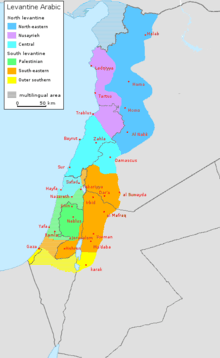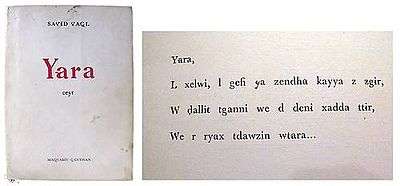Lebanese Arabic
| Lebanese Arabic | |
|---|---|
| North-Central Levantine Arabic | |
| اللبنانية | |
| Native to | Lebanon |
|
Afro-Asiatic
| |
| Arabic alphabet, Latin | |
| Language codes | |
| ISO 639-3 | – |
| Glottolog | None |
|
Lebanese Arabic in cyan | |
Lebanese Arabic or Lebanese is a variety of Levantine Arabic, indigenous to and spoken primarily in Lebanon, with significant linguistic influences borrowed from other Middle Eastern and European languages, and is in some ways unique from other varieties of Arabic. Due to multilingualism among Lebanese people (the vast majority of the Lebanese people are trilingual - Lebanese Arabic, French, English), it is not uncommon for Lebanese people to mix Lebanese Arabic, French, and English languages into their daily speech.
Differences from Standard Arabic
Lebanese Arabic shares many features with other modern varieties of Arabic. Lebanese Arabic, like many other spoken Levantine Arabic varieties, has a syllable structure very different from that of Modern Standard Arabic. While Standard Arabic can have only one consonant at the beginning of a syllable, after which a vowel must follow, Lebanese Arabic commonly has two consonants in the onset.
- Morphology: simpler, without any mood and case markings.
- Number: verbal agreement regarding number and gender is required for all subjects, whether already mentioned or not.
- Vocabulary: many borrowings from other languages; most prominently Syriac-Aramaic, western-Aramaic Ottoman Turkish, French, and Greek, as well as, less significantly, from English.
- About 50 percent of the Lebanese grammatical structure is due to Aramaic influences.
Examples
- The following example demonstrates two differences between Standard Arabic (Literary Arabic) and Spoken Lebanese Arabic: Coffee (قهوة), Literary Arabic: /ˈqahwa/; Lebanese Arabic: [ˈʔahwe]. The voiceless uvular plosive /q/ corresponds to a glottal stop [ʔ], and the final vowel ([æ~a~ɐ]) commonly written with tāʾ marbūtah (ة) is raised to [e].
- As a general rule of thumb, the voiceless uvular plosive /q/ is replaced with glottal stop [ʔ], e.g. /daqiːqa/ "minute" becomes [dʔiːʔa]. This debuccalization of /q/ is a feature shared with Syrian Arabic, Egyptian Arabic, and Maltese.
- The exception for this general rule is the Druze of Lebanon who, like the Druze of Syria and Israel, have retained the pronunciation of /q/ in the centre of direct neighbours who have substituted the /q/ for the [ʔ] (example: "Heart" is /qalb/ in Literary Arabic, becomes [ˈʔaleb] or [ʔalb], which is similar in Syrian, Palestinian, Egyptian and Maltese. The use of /q/ by Druze is particularly prominent in the mountains and less so in urban areas.
- Unlike most other varieties of Arabic, a few dialects of Lebanese Arabic have retained the classical diphthongs /aj/ and /aw/ (pronounced in Lebanese Arabic as [aɪ] and [aʊ]), which were monophthongised into [eː] and [oː] elsewhere, although the majority of Lebanese Arabic dialects realize them as [oʊ] and [eɪ]. In urban dialects (i.e. Beiruti) [eː] has replaced /aj/ and sometimes medial /aː/, and [e] has replaced final /i/ making it indistinguishable with tāʾ marbūtah (ة). Also, [oː] has replaced /aw/; [o] replacing some short /u/s. In singing, the /aj/, /aw/ and medial /aː/ are usually maintained for artistic values.
- /t/ and /θ/ are both pronounced [t].
Phonology
Consonants
| Labial | Alveolar | Palatal | Velar/ Uvular |
Pharyngeal | Glottal | |||
|---|---|---|---|---|---|---|---|---|
| plain | emphatic | |||||||
| Nasal | m | n | ||||||
| Stop | voiceless | (p) | t | tˤ | k | ʔ | ||
| voiced | b | d | dˤ | (ɡ) | ||||
| Fricative | voiceless | f | s | sˤ | ʃ | x | ħ | h |
| voiced | (v) | z | zˤ | ʒ | ɣ | ʕ | ||
| Tap/trill | r | |||||||
| Approximant | l | j | w | |||||
- The phonemes /p, v/ are not native to Lebanese Arabic and are only found in loanwords. They are sometimes realized as [b] and [f] respectively.
- The velar stop /g/ occurs in native Lebanese Arabic words but is generally restricted to loanwords. It is realized as [k] by some speakers.
Vowels and diphthongs

Comparison
This table shows the correspondence between general Lebanese Arabic vowel phonemes and their counterpart realizations in Modern Standard Arabic (MSA) and other Levantine Arabic varieties.
| Lebanese Arabic | MSA | Southern | Central | Northern |
|---|---|---|---|---|
| /æ/ | [a] | [ɑ] or [ʌ] | [ɑ] or [ʌ] | [ɔ] or [ɛ] |
| /j/ | [i] or [u] | [e] | [ə] | [e] or [o] |
| /ʊ/ | [u] | [o] or [ʊ] | [o] | [o] |
| /e/1 | [a] | [e]1 | [e]1 | [e]1 |
| /ɛ:/ | [a:] | [a:] | [æ:] | [e:] |
| /ɔ:/ | [a:] | [a:] | [ɑ:] | [o:] |
| /e:/ | [a:] | [a] | [e] | [e] |
| /i/: | [i:] | [i:] | [i:] | [i:] |
| /i~e/ | [i:] | [i] | [i] | [i] |
| /u:/ | [u:] | [u:] | [u:] | [u:] |
| /ej~e:/ | [aj] | [e:] | [e:] | [e:] |
| /oʊ~o:/ | [aw] | [o:] | [o:] | [o:] |
^1 After back consonants this is pronounced [ʌ] in Lebanese Arabic, Central and Northern Levantine varieties, and as [ɑ] in Southern Levantine varieties
Regional Lebanese Arabic dialects
Although there is a common Lebanese Arabic dialect mutually understood by Lebanese people, there are regionally distinct variations with, at times, unique pronunciation, grammar, and vocabulary.
Widely used regional dialects include:
- Beiruti dialects, further distributed according to neighborhoods, the notable ones being Achrafieh dialect, Basta dialect, Ras Beirut dialect, etc.
- Northern dialects, further distributed regionally, the most notable ones being Tripoli dialect, Zgharta dialect, Bsharri dialect, Koura dialect, Akkar dialect.
- Southern dialects, with notable ones being the Tyre and Bint Jbeil dialects.
- Beqaa dialects, further divided into dialects, the notable ones being Zahlé and Baalbek-Hermel dialects.
- Mount Lebanon dialects, further divided into regional dialects like the Keserwan dialect, the Matin dialect, Shouf dialect, etc.
Writing system
Lebanese Arabic is rarely written, except in novels where a dialect is implied or in some types of poetry that do not use classical Arabic at all. Lebanese Arabic is also utilized in many Lebanese songs, theatrical pieces, local television and radio productions, and very prominently in zajal.
Formal publications in Lebanon, such as newspapers, are typically written in Modern Standard Arabic, French, or English.
While Arabic script is usually employed, informal usage such as online chat may mix and match Latin letter transliterations. The Lebanese poet Saïd Akl proposed the use of the Latin alphabet but did not gain wide acceptance. Whereas some works, such as Romeo and Juliet and Plato's Dialogues have been transliterated using such systems, they have not gained widespread acceptance. Yet, now, most Arabic web users, when short of an Arabic keyboard, transliterate the Lebanese Arabic words in the Latin alphabet in a pattern similar to the Said Akl alphabet, the only difference being the use of digits to render the Arabic letters with no obvious equivalent in the Latin alphabet.
There is still today no generally accepted agreement on how to use the Latin alphabet to transliterate Lebanese Arabic words.
In 2010, The Lebanese Language Institute has released a Lebanese Arabic keyboard layout and made it easier to write Lebanese Arabic in a Latin script, using unicode-compatible symbols to substitute for missing sounds.[1]
Said Akl's orthography
- Capitalization and punctuation are used normally the same way they are used in French and English languages.
- Some written consonant-letters, depending on their position, inherited a preceding vowel. As L and T.
- Emphatic consonants are not distinguished from normal ones, with the exception of /zˤ/ represented by ƶ. Probably Said Akl did not acknowledge any other emphatic consonant.
- Stress is not marked.
- Long vowels and geminated consonants are represented by double letters.
- Ç which represents /ʔ/ was written even initially.
- All the basic Latin alphabet are used, in addition to other diacriticized ones. Most of the letters loosely represent their IPA counterparts, with some exceptions:
| Letter | Corresponding phoneme(s) | Additional information |
|---|---|---|
| a | /a/, /ɑ/ | |
| aa | /aː/, /ɑː/ | |
| c | /ʃ/ | |
| ç | /ʔ/ | The actual diacritic looks like a stroke |
| g | /ɣ/ | |
| i | /ɪ/, /i/ | Represents /i/ word-finally |
| ii | /iː/ | |
| j | /ʒ/ | |
| k | /χ/ | |
| q | /k/ | |
| u | /ʊ/, /u/ | Represents /u/ word-finally |
| uu | /uː/ | |
| x | /ħ/ | |
| y | /ɪ/ | |
| ȳ | /ʕ/ | The actual diacritic looks like a stroke connected to the upper-left spoke of the letter |
| ƶ | /zˤ/ |
Lebanese Arabic verbs
Lebanese Arabic verbs, even though they share root similarities with many Arabic varieties, have characteristics that set them apart from verbs in other Arabic varieties.
References
- ↑ Lebanese Language Institute: Lebanese Latin Letters The Lebanese Latin Letters
Bibliography
- Spoken Lebanese. Maksoud N. Feghali, Appalachian State University. Parkway Publishers, 1999 (ISBN 978-1-887905-14-5)
- Michel T. Feghali, Syntaxe des parlers arabes actuels du Liban, Geuthner, Paris, 1928.
- Elie Kallas, 'Atabi Lebnaaniyyi. Un livello soglia per l'apprendimento del neoarabo libanese, Cafoscarina, Venice, 1995.
- Angela Daiana Langone, Btesem ente lebneni. Commedia in dialetto libanese di Yahya Jaber, Università degli Studi La Sapienza, Rome, 2004.
- Jérome Lentin, "Classification et typologie des dialectes du Bilad al-Sham", in Matériaux Arabes et Sudarabiques n. 6, 1994, 11–43.
- Plonka Arkadiusz, L’idée de langue libanaise d’après Sa‘īd ‘Aql, Paris, Geuthner, 2004, ISBN 978-2-7053-3739-1
- Plonka Arkadiusz, "Le nationalisme linguistique au Liban autour de Sa‘īd ‘Aql et l’idée de langue libanaise dans la revue «Lebnaan» en nouvel alphabet", Arabica, 53 (4), 2006, 423–471.
- Franck Salameh, "Language, Memory, and Identity in the Middle East", Lexington Books, 2010.
- lebaneselanguage.org, "Lebanese vs Arabic", Lebanese Language Institute, March 6, 2010.
External links
| Wikivoyage has a travel guide for Lebanese Arabic phrasebook. |
- Learn Arabic Lebanese with Hiba Najem
- Lebanese Language Institute
- Lebanese Arabic Latin alphabet
- Manual with grammar of Lebanese Arabic for the Dutch UNIFIL detachment
- Summary of commonly used conventions of writing the Lebanese Arabic spoken language using Latin alphabet


